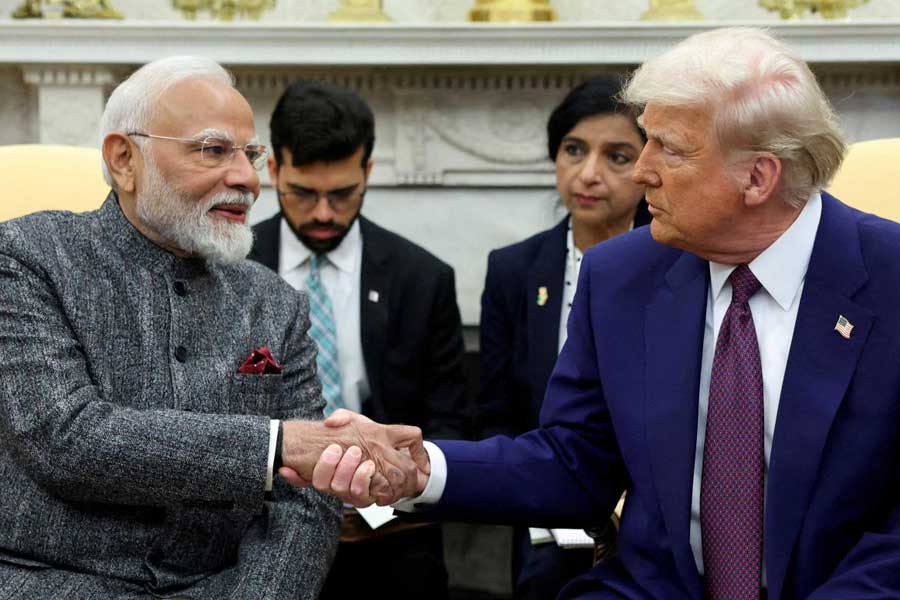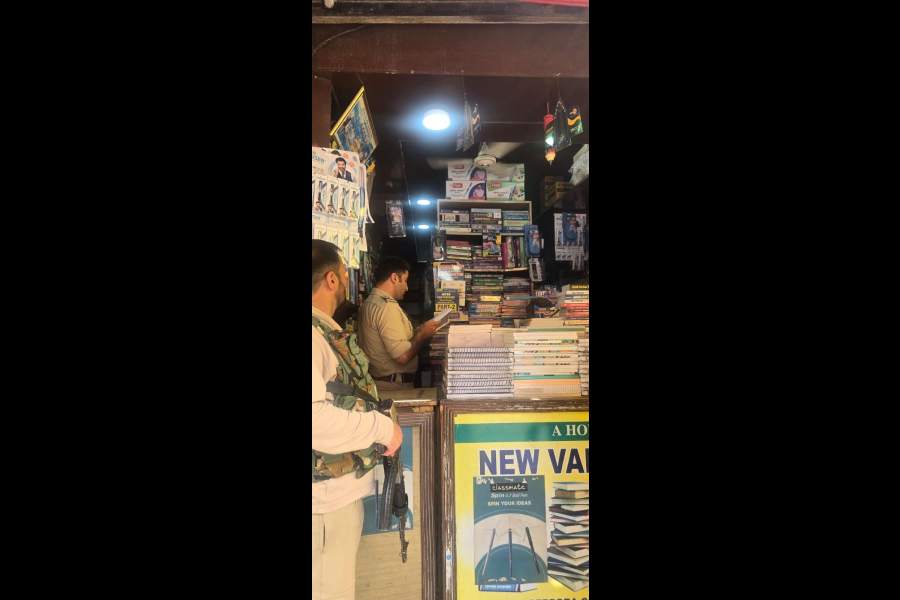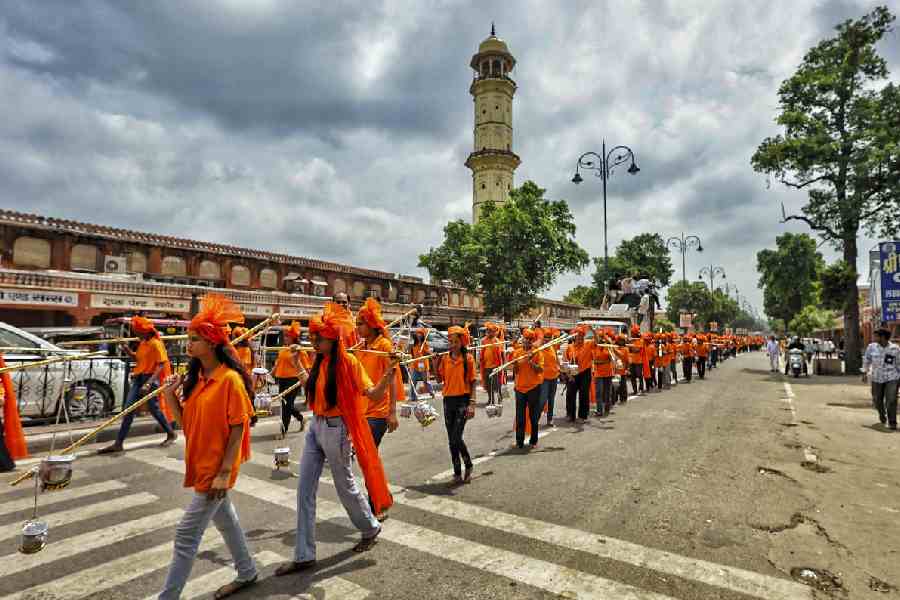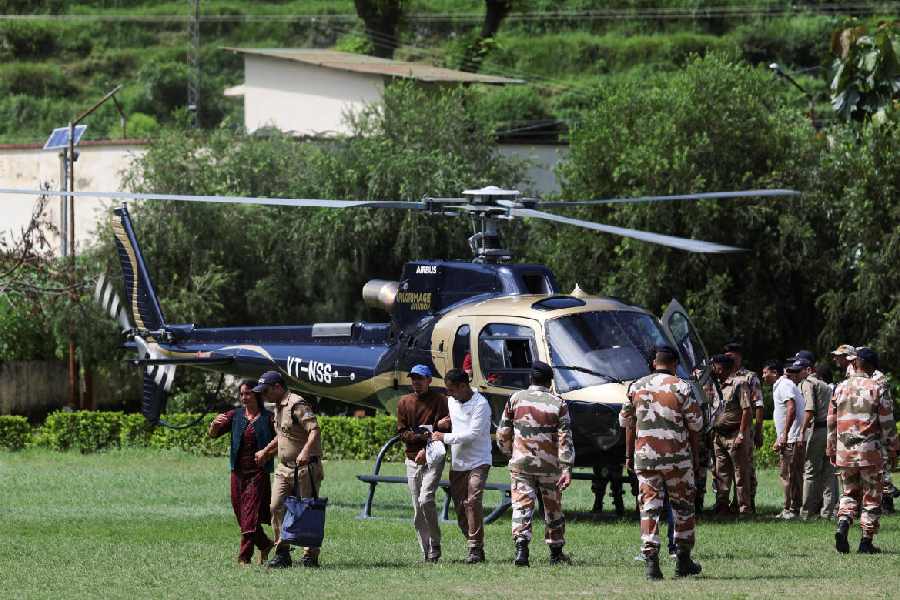 |
| (Left) Anish Kapoor and Cecil Balmond |
Middlesbrough, June 9: Cecil Balmond, the innovative Sri Lankan architect described by Indian sculptor Anish Kapoor as “the world’s greatest engineer”, has indicated he would like to try and design an amazing piece of architecture for India, possibly something for the heritage waterfront in Calcutta.
He expressed his wish to this newspaper on the eve of the formal inauguration tomorrow in the northeast of England of an awe-inspiring piece of public sculpture called Temenos that he and his friend Anish have designed.
It is thought to be the biggest in Britain and is the first of five for the region, which has been hit hard by years of neglect, rising unemployment and finally the recession but is now determined under the leadership of Tees Valley Unlimited to use inspirational art to lift the spirit of the people.
Mumbai-born Anish, who is now widely acclaimed as “one of the world’s greatest living artists” but who has yet to have his first exhibition in India, said: “I relish the chance to work in an area like the Tees Valley where there is a real and growing appreciation of art and its place within resurgent communities.”
Anish and Cecil, who have had a remarkable collaboration for many years, are also creating the “Mittal Tower” in London to celebrate the 2012 Olympics.
Cecil revealed he had almost succeeded in getting a project, such as a stadium in Ranchi, off the ground in India but it has not happened yet.
“Lakshmi (Mittal) told me the captain of the Indian cricket team (Jharkhand boy M.S. Dhoni) is ‘a friend of mine’,” recalled Cecil, who is travelling to Middlesbrough with Anish for tomorrow’s ceremony for which a helicopter has been hired to show Temenos to best effect.
In Greek, Temenos refers to “an area reserved for the Gods”.
If the 156-tonne giant steel structure, 110 metres long and suspended 50 metres high above Middlehaven Dock with steel cables stretched between two massive rings, could be physically shifted to the Hooghly waterfront, it would certainly become a topic for heated Coffee House artistic criticism, probably favourable.
The circular ring is 32m in diameter and the elliptical one 28m by 16m. In all, 64 cables are stretched between the rings but “tied” with other cables at regular intervals to give the structure its distinctive shape.
The shape changes as the observer walks round the structure, with the connecting cables vanishing from view when the light falls on them in a particular way.
Yesterday, with dark clouds rolling down from the green Cleveland Hills in the distance and rain lashing Middlesbrough, it was the perfect Shakespearean moment for The Telegraph to be given an exclusive preview.
Given that Middlesbrough was once “the steel capital of the world” and sent its infrastructural products to India, especially to Calcutta, Anish and Cecil wanted something to reflect the region’s industrial past — “strong and brutal”.
But they had also wanted to create something ethereal, Cecil said, “something mysterious, it’s there and it isn’t there”.
Cecil, who has just returned from delivering a lecture in Sri Lanka, emphasised: “I would love to do something in Calcutta.”
If Temenos represents the new, the much loved symbol of the old is the Transporter Bridge in the background, still functional although it was commissioned in 1911. The latter will remind anyone who knows Calcutta of Howrah bridge (which was built by the local Cleveland Bridge Company from Teesside using Indian steel).
Calcutta should be aware that Anish and Cecil don’t come cheap — Temenos costs £2.7 million. Believing in the power of art to help in the regeneration of the depressed northeast, the expense has been shared by Tees Valley Regeneration (now called Tees Valley Unlimited), the Northern Way, Regional Development Agency One North East, the Homes and Communities Agency and such key partners as the Arts Council England, Northern Rock Foundation, BioRegional Quintain, Middlesbrough Football Club and Middlesbrough Council.
One man who would have been proud to have seen Temenos come to life is Ashok Kumar, the Labour MP for Middlesbrough South and East Cleveland who died in March, aged 53. He fought to forestall the “mothballing” of Tata’s Corus steel plant in nearby Teesside where another Anish-Cecil sculpture — the Tees Valley Giants — is planned.
The work involved in installing Temenos certainly reflects British engineering at its best.
Mark Hopgood, the project manager from Tees Valley Unlimited who has been thanked by Anish and Cecil for the attention to detail shown by his team, said yesterday: “There were 10 months of work on site and three months of work before that in the workshop. There were a lot of engineering issues.”
Hopgood explained: “There was a lot of detailed computer modelling required to actually get the net in its final structure. That has been done by some specialist engineers. The shape itself was obviously designed by Anish and Cecil. In particular, the engineering-modelling was undertaken by Cecil’s team at Arup’s (an engineering firm). All the longitudinal cables are cut precisely to length to the millimetre. There are just over five miles of cable in all. The structure itself has a 120-year design life. Thanks to Anish and Cecil, this is a fantastic engineering feat.”
Will it grow in the affections of the locals?
“I certainly hope so — I think they will come to love it,” Hopgood speculated.
The Telegraph did not wish to be flippant but wondered if Temenos could be decorated with lights, say, for Diwali.
“It has been mentioned,” Hopgood conceded. “Anish initially did not want lights but we might look at that in the future.”










